Abstract
1. Electrical stimulation of the brachial nerves at 3 Hz (15 V, 0.2 ms), in sodium pentobarbitone-anaesthetized rats whose renal arterial pressure was held constant, elicited a 26% increase in systemic blood pressure, a 15% rise in heart rate, an 11% reduction in renal blood flow, did not alter glomerular filtration rate and significantly reduced absolute and fractional sodium excretions and urine flow by 44, 49 and 31%, respectively. 2. In a separate group of rats, brachial nerve stimulation at 3 Hz increased plasma renin activity approximately 2-fold, while in animals in which the brachial nerves were not stimulated plasma renin activity did not change. 3. Following inhibition of the renin-angiotensin system with captopril or sar-1-ile-8-angiotensin II, brachial nerve stimulation resulted in similar increases in systemic blood pressure and heart rate as in the animals with an intact renin-angiotensin system but, in captopril-infused rats, did not change renal haemodynamics or urine flow while absolute and fractional sodium excretions were reduced by 20 and 25%, respectively. In sar-1-ile-8-angiotensin II-infused animals, similar nerve stimulation decreased renal blood flow by 12%, glomerular filtration rate by 7% and absolute and fractional sodium excretions and urine flow by 25, 18 and 18%, respectively. These decreases in sodium and water output were significantly smaller than those observed in animals with an intact renin-angiotensin system. 4. Stimulation of the brachial nerves increased post-ganglionic efferent renal nerve activity by 20% and the magnitude of this response was unaffected following inhibition of the renin-angiotensin system. 5. The results show that low rates of brachial nerve stimulation in the rat can increase efferent renal nerve activity and result in an antinatriuresis and antidiuresis which is dependent on the presence of angiotensin II, and appears to be due to an action of angiotensin II at the level of the kidney.
Full text
PDF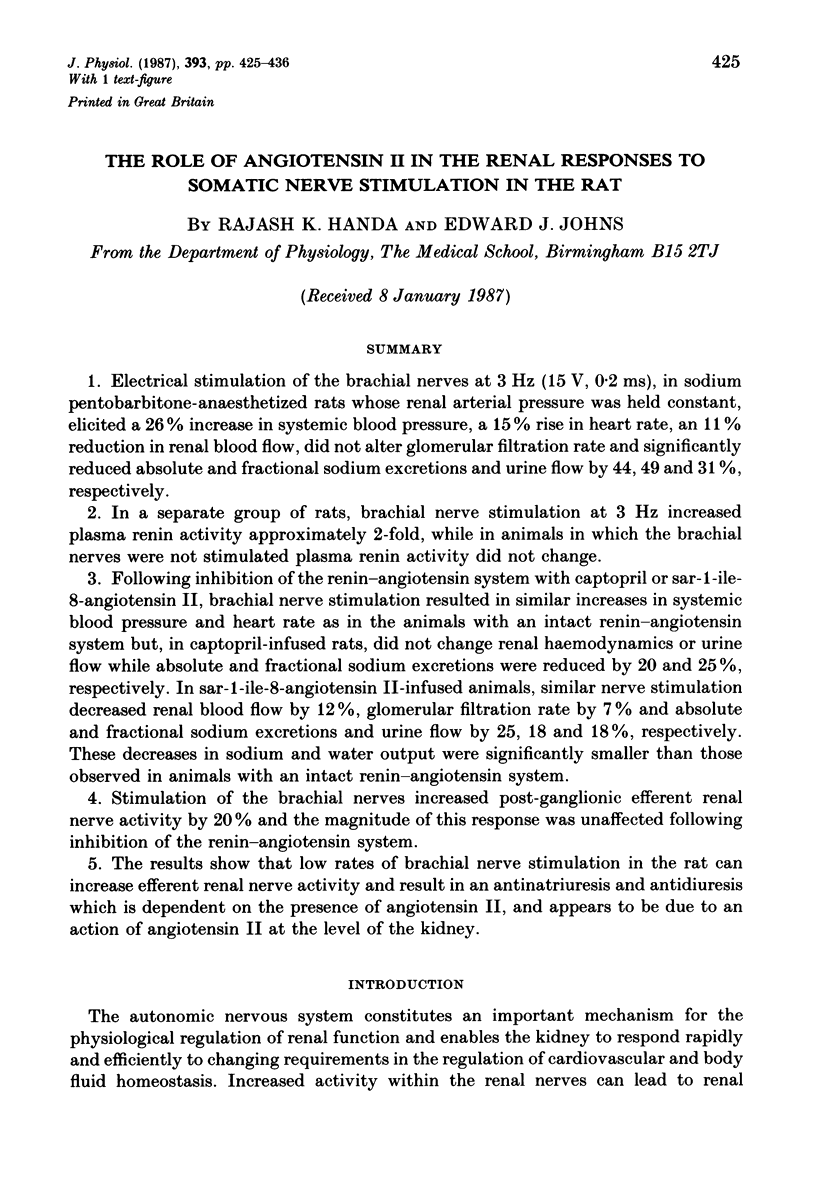
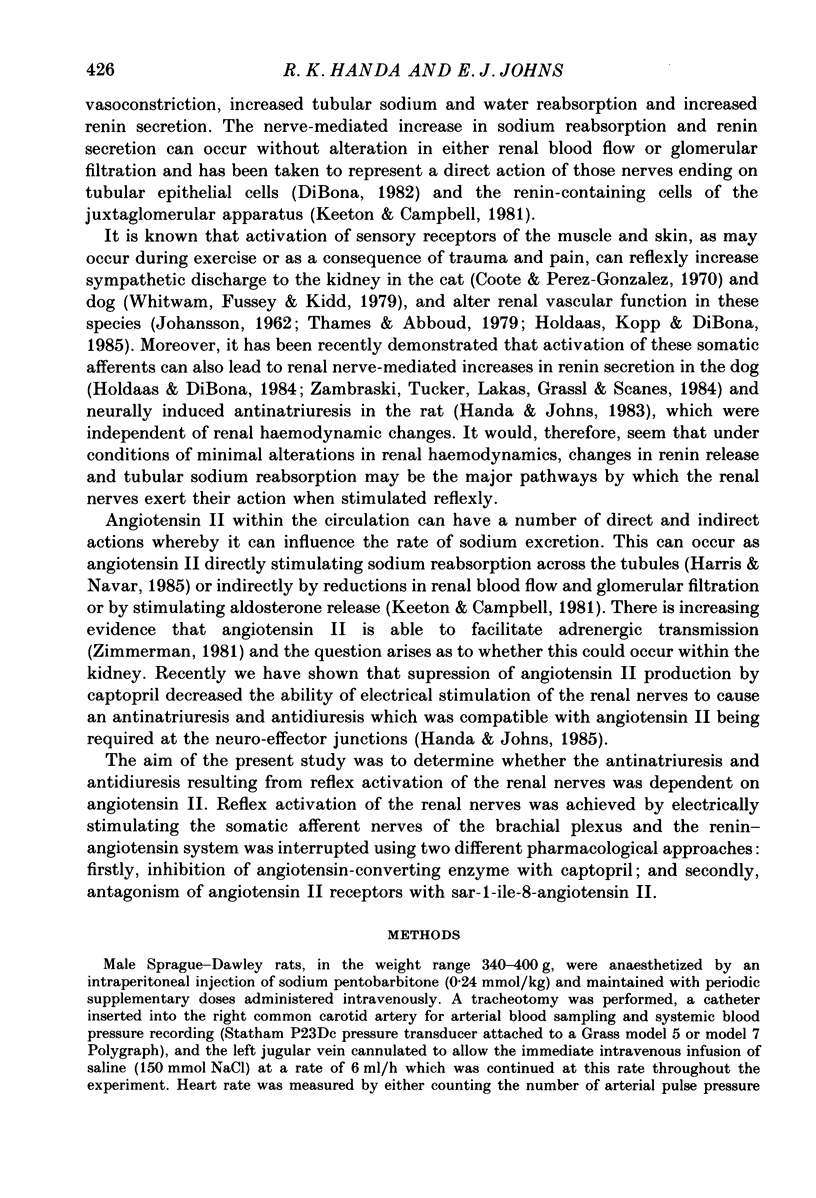
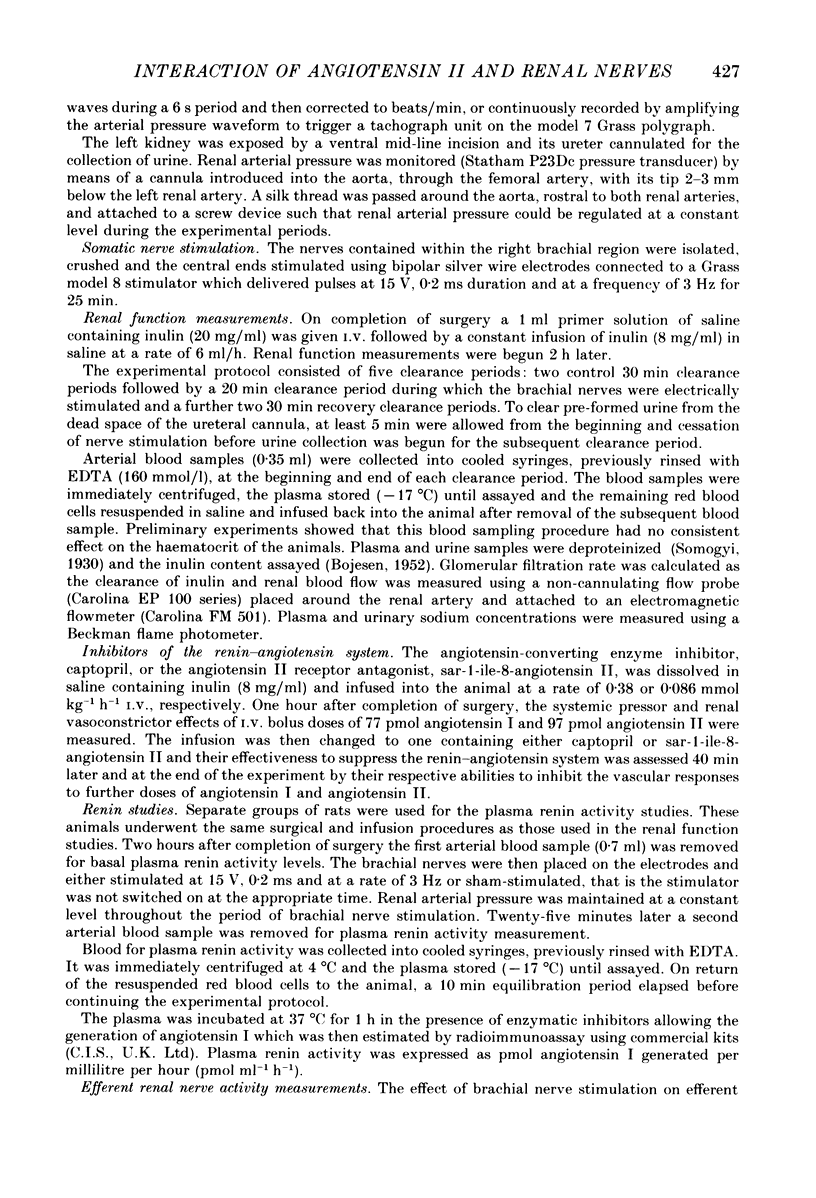
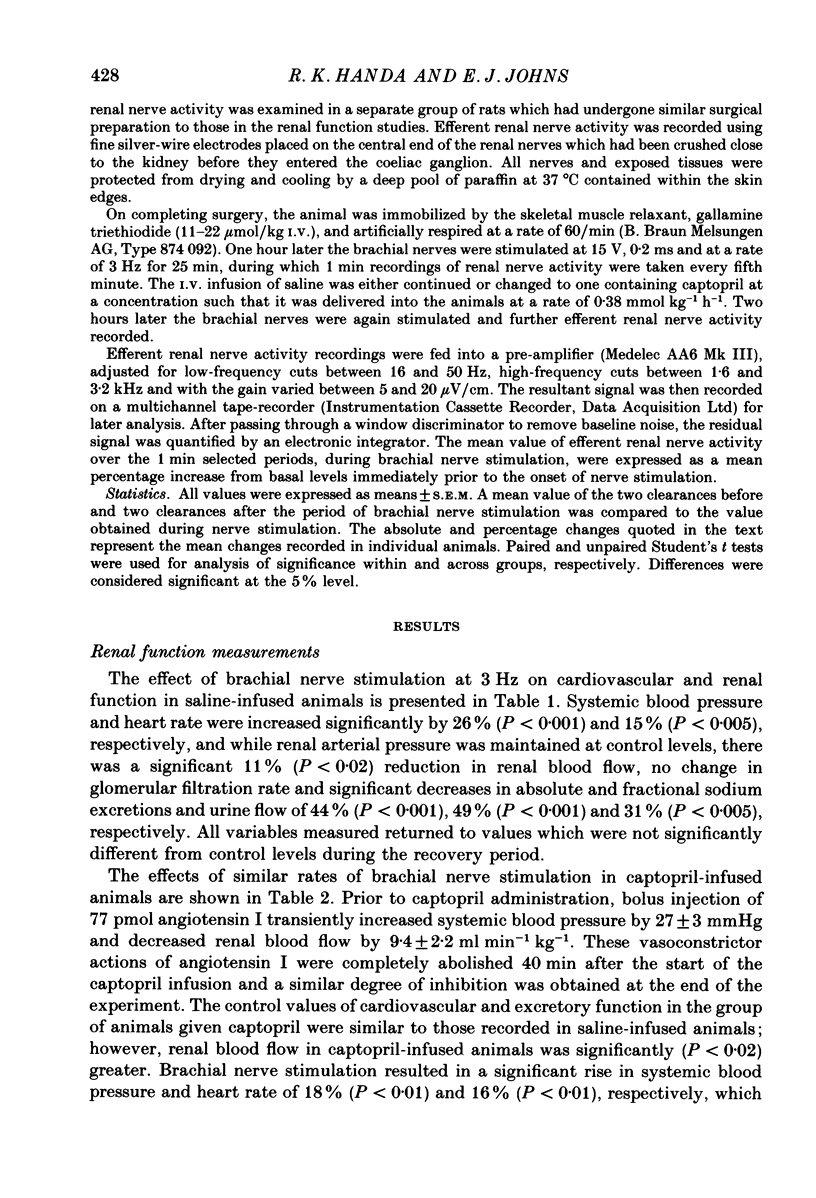

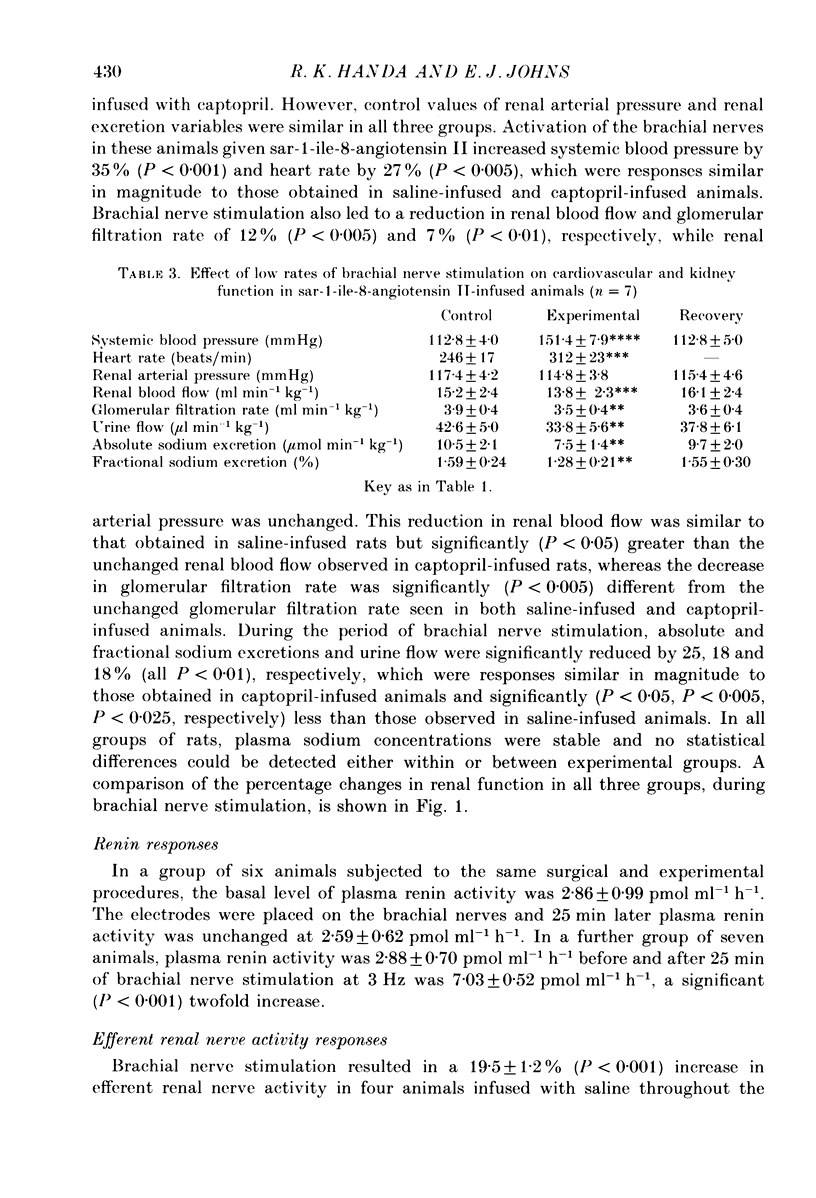
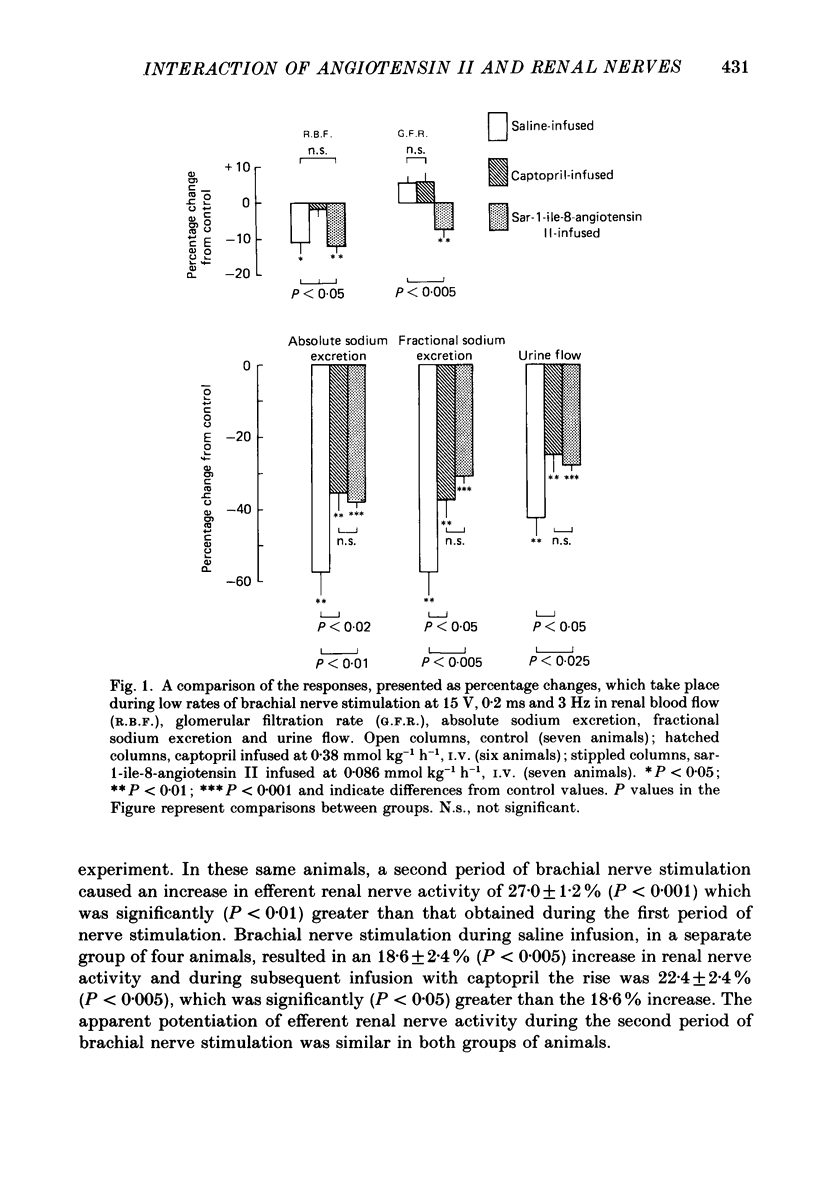
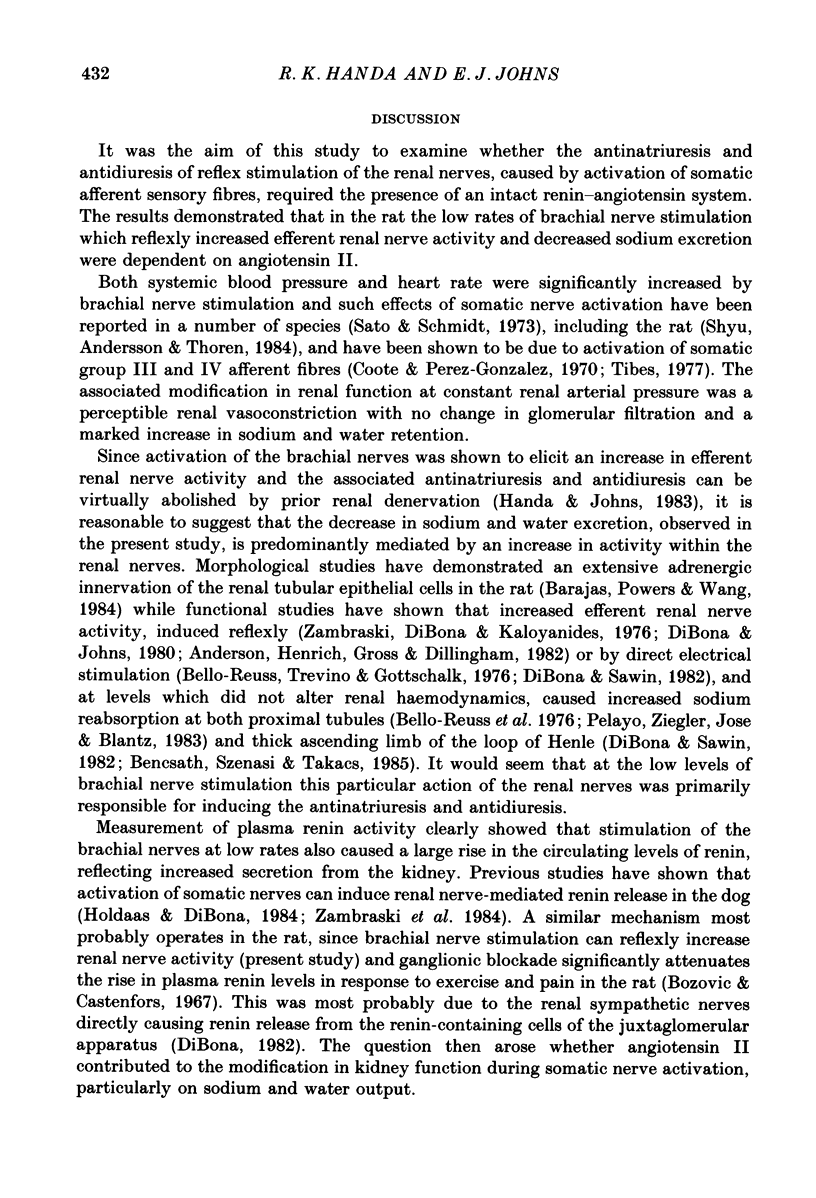
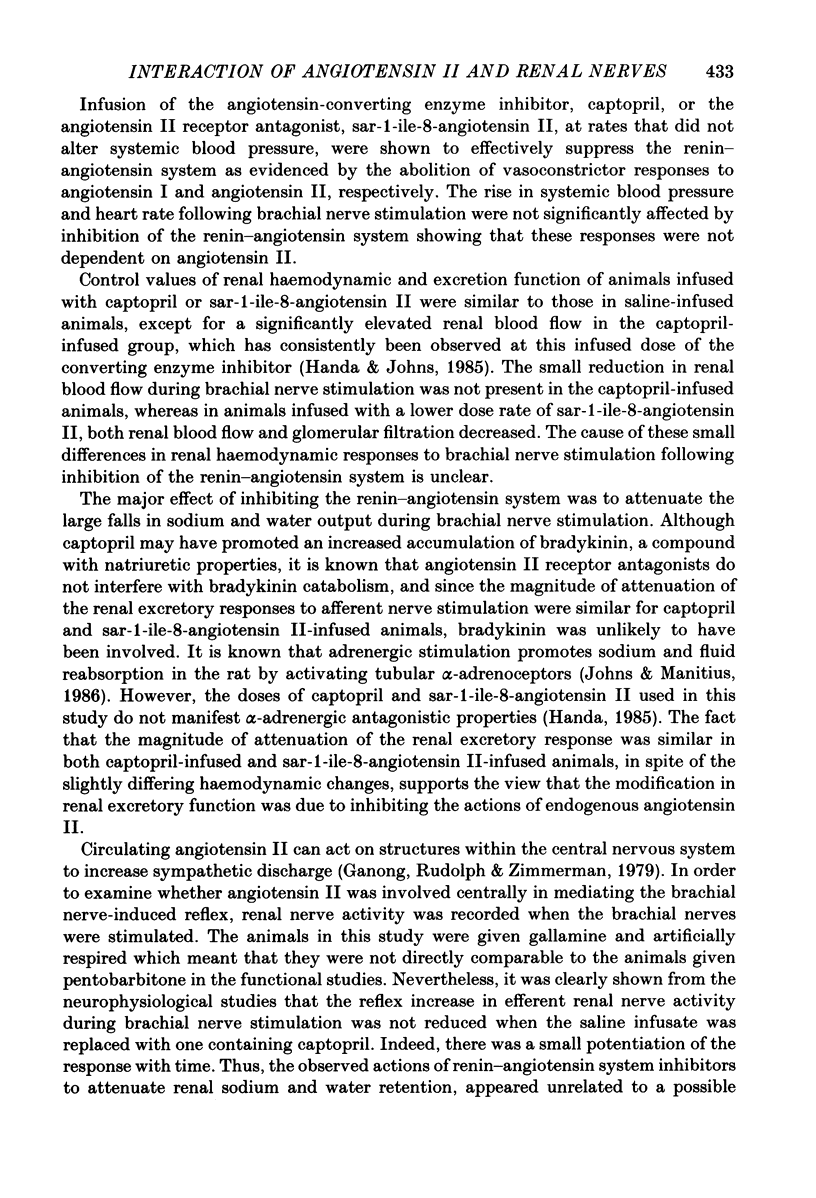
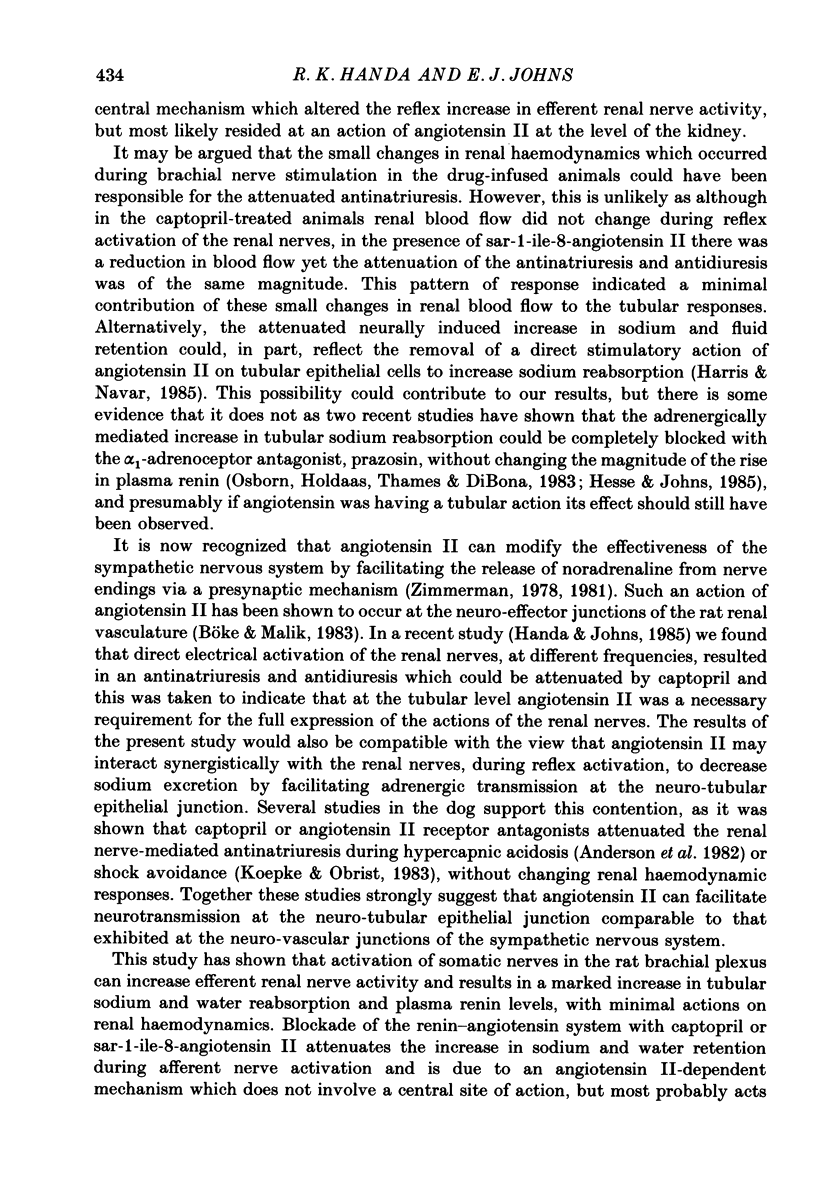
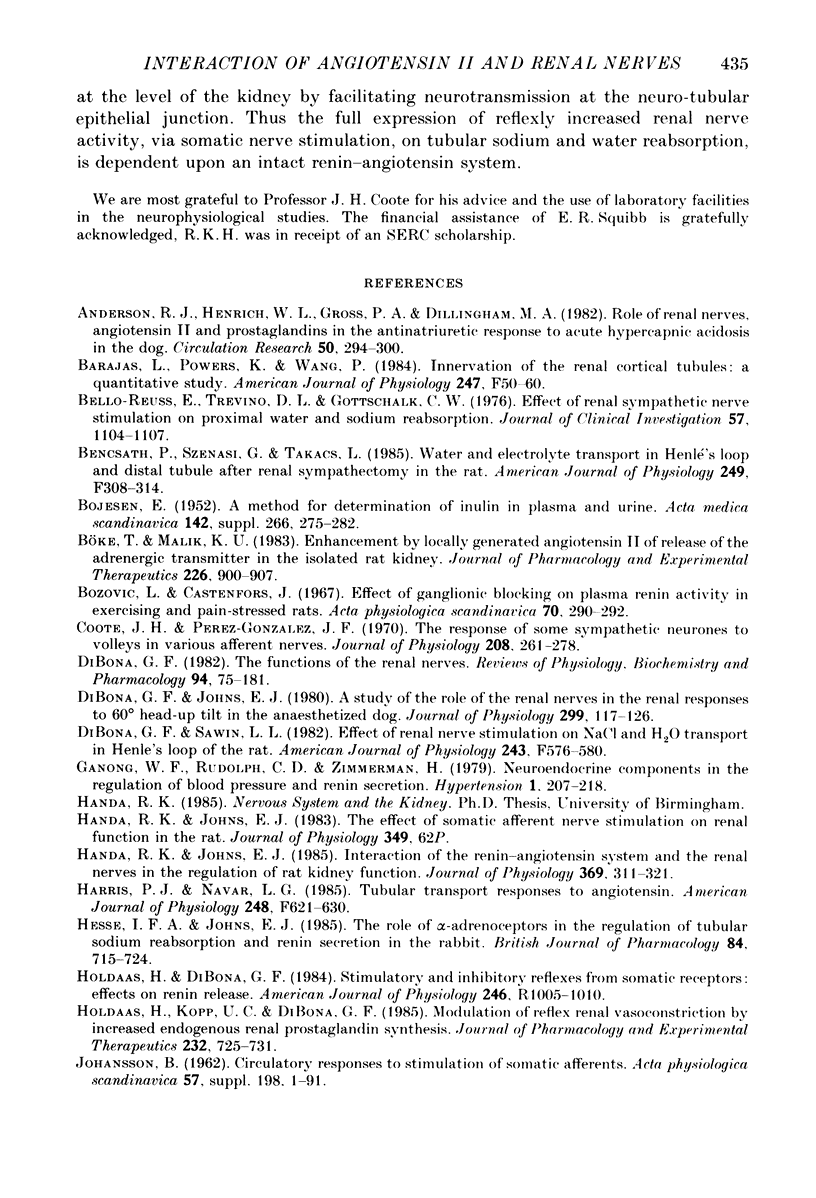
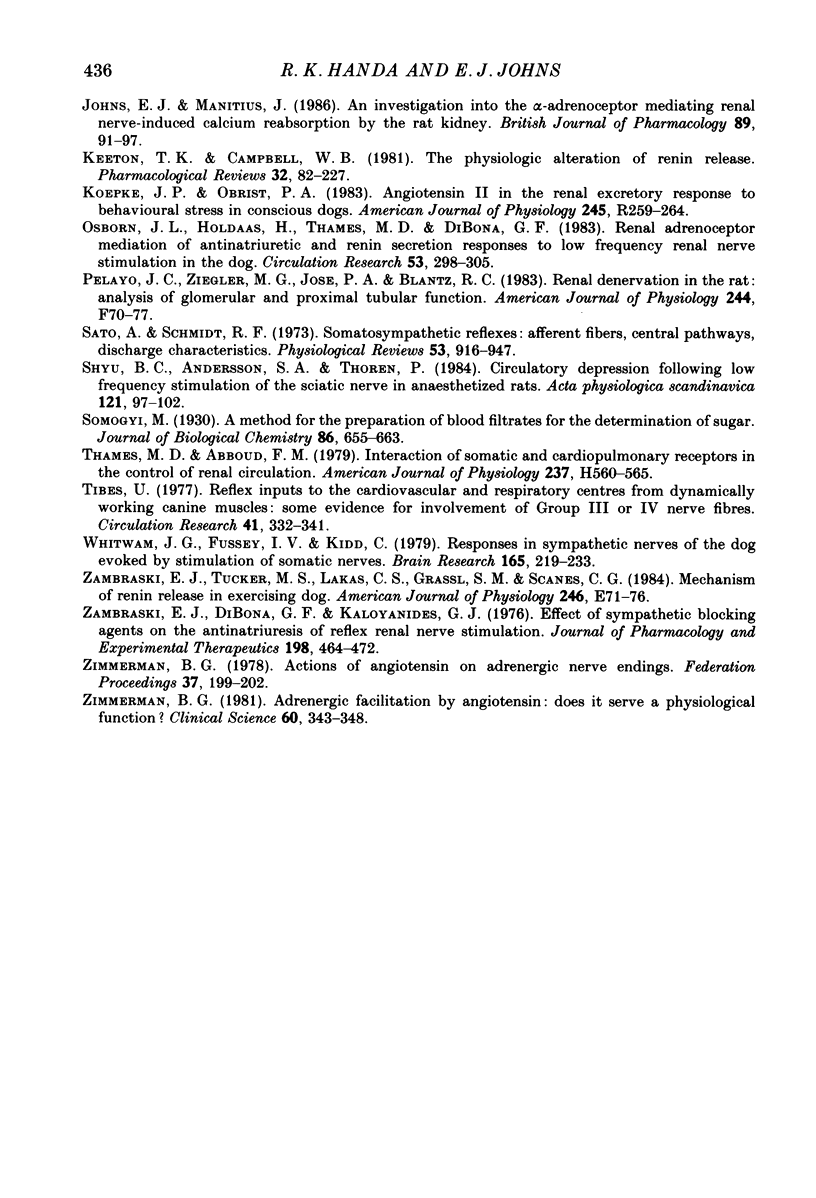
Selected References
These references are in PubMed. This may not be the complete list of references from this article.
- Anderson R. J., Henrich W. L., Gross P. A., Dillingham M. A. Role of renal nerves, angiotensin II, and prostaglandins in the antinatriuretic response to acute hypercapnic acidosis in the dog. Circ Res. 1982 Feb;50(2):294–300. doi: 10.1161/01.res.50.2.294. [DOI] [PubMed] [Google Scholar]
- BOJESEN E. A method for determination of inulin in plasma and urine. Acta Med Scand Suppl. 1952;266:275–282. doi: 10.1111/j.0954-6820.1952.tb13376.x. [DOI] [PubMed] [Google Scholar]
- Barajas L., Powers K., Wang P. Innervation of the renal cortical tubules: a quantitative study. Am J Physiol. 1984 Jul;247(1 Pt 2):F50–F60. doi: 10.1152/ajprenal.1984.247.1.F50. [DOI] [PubMed] [Google Scholar]
- Bell-Reuss E., Trevino D. L., Gottschalk C. W. Effect of renal sympathetic nerve stimulation on proximal water and sodium reabsorption. J Clin Invest. 1976 Apr;57(4):1104–1107. doi: 10.1172/JCI108355. [DOI] [PMC free article] [PubMed] [Google Scholar]
- Bencsáth P., Szénási G., Takács L. Water and electrolyte transport in Henle's loop and distal tubule after renal sympathectomy in the rat. Am J Physiol. 1985 Aug;249(2 Pt 2):F308–F314. doi: 10.1152/ajprenal.1985.249.2.F308. [DOI] [PubMed] [Google Scholar]
- Bozović L., Castenfors J. Effect of ganglionic blocking on plasma renin activity in exercising and pain-stressed rats. Acta Physiol Scand. 1967 Jul-Aug;70(3):290–292. doi: 10.1111/j.1748-1716.1967.tb03628.x. [DOI] [PubMed] [Google Scholar]
- Böke T., Malik K. U. Enhancement by locally generated angiotensin II of release of the adrenergic transmitter in the isolated rat kidney. J Pharmacol Exp Ther. 1983 Sep;226(3):900–907. [PubMed] [Google Scholar]
- Coote J. H., Perez-Gonzalez J. F. The response of some sympathetic neurones to volleys in various afferent nerves. J Physiol. 1970 Jun;208(2):261–278. doi: 10.1113/jphysiol.1970.sp009118. [DOI] [PMC free article] [PubMed] [Google Scholar]
- DiBona G. F., Johns E. J. A study of the role of renal nerves in the renal responses to 60 degree head-up tilt in the anaesthetized dog. J Physiol. 1980 Feb;299:117–126. doi: 10.1113/jphysiol.1980.sp013114. [DOI] [PMC free article] [PubMed] [Google Scholar]
- DiBona G. F., Sawin L. L. Effect of renal nerve stimulation on NaCl and H2O transport in Henle's loop of the rat. Am J Physiol. 1982 Dec;243(6):F576–F580. doi: 10.1152/ajprenal.1982.243.6.F576. [DOI] [PubMed] [Google Scholar]
- Ganong W. F., Rudolph C. D., Zimmermann H. Neuroendocrine components in the regulation of blood pressure and renin secretion. Hypertension. 1979 May-Jun;1(3):207–218. doi: 10.1161/01.hyp.1.3.207. [DOI] [PubMed] [Google Scholar]
- Handa R. K., Johns E. J. Interaction of the renin-angiotensin system and the renal nerves in the regulation of rat kidney function. J Physiol. 1985 Dec;369:311–321. doi: 10.1113/jphysiol.1985.sp015903. [DOI] [PMC free article] [PubMed] [Google Scholar]
- Hesse I. F., Johns E. J. The role of alpha-adrenoceptors in the regulation of renal tubular sodium reabsorption and renin secretion in the rabbit. Br J Pharmacol. 1985 Mar;84(3):715–724. doi: 10.1111/j.1476-5381.1985.tb16154.x. [DOI] [PMC free article] [PubMed] [Google Scholar]
- Holdaas H., Kopp U. C., DiBona G. F. Modulation of reflex renal vasoconstriction by increased endogenous renal prostaglandin synthesis. J Pharmacol Exp Ther. 1985 Mar;232(3):725–731. [PubMed] [Google Scholar]
- JOHANSSON B. Circulatory responses to stimulation of somatic afferents with special reference to depressor effects from muscle nerves. Acta Physiol Scand Suppl. 1962;198:1–91. [PubMed] [Google Scholar]
- Johns E. J., Manitius J. An investigation into the alpha-adrenoceptor mediating renal nerve-induced calcium reabsorption by the rat kidney. Br J Pharmacol. 1986 Sep;89(1):91–97. doi: 10.1111/j.1476-5381.1986.tb11124.x. [DOI] [PMC free article] [PubMed] [Google Scholar]
- Koepke J. P., Obrist P. A. Angiotensin II in the renal excretory response to behavioral stress in conscious dogs. Am J Physiol. 1983 Aug;245(2):R259–R264. doi: 10.1152/ajpregu.1983.245.2.R259. [DOI] [PubMed] [Google Scholar]
- Osborn J. L., Holdaas H., Thames M. D., DiBona G. F. Renal adrenoceptor mediation of antinatriuretic and renin secretion responses to low frequency renal nerve stimulation in the dog. Circ Res. 1983 Sep;53(3):298–305. doi: 10.1161/01.res.53.3.298. [DOI] [PubMed] [Google Scholar]
- Pelayo J. C., Ziegler M. G., Jose P. A., Blantz R. C. Renal denervation in the rat: analysis of glomerular and proximal tubular function. Am J Physiol. 1983 Jan;244(1):F70–F77. doi: 10.1152/ajprenal.1983.244.1.F70. [DOI] [PubMed] [Google Scholar]
- Sato A., Schmidt R. F. Somatosympathetic reflexes: afferent fibers, central pathways, discharge characteristics. Physiol Rev. 1973 Oct;53(4):916–947. doi: 10.1152/physrev.1973.53.4.916. [DOI] [PubMed] [Google Scholar]
- Shyu B. C., Andersson S. A., Thorén P. Circulatory depression following low frequency stimulation of the sciatic nerve in anesthetized rats. Acta Physiol Scand. 1984 Jun;121(2):97–102. doi: 10.1111/j.1748-1716.1984.tb07434.x. [DOI] [PubMed] [Google Scholar]
- Thames M. D., Abboud F. M. Interaction of somatic and cardiopulmonary receptors in control of renal circulation. Am J Physiol. 1979 Nov;237(5):H560–H565. doi: 10.1152/ajpheart.1979.237.5.H560. [DOI] [PubMed] [Google Scholar]
- Tibes U. Reflex inputs to the cardiovascular and respiratory centers from dynamically working canine muscles. Some evidence for involvement of group III or IV nerve fibers. Circ Res. 1977 Sep;41(3):332–341. doi: 10.1161/01.res.41.3.332. [DOI] [PubMed] [Google Scholar]
- Whitwam J. G., Kidd C., Fussey I. V. Responses in sympathetic nerves of the dog evoked by stimulation of somatic nerves. Brain Res. 1979 Apr 13;165(2):219–233. doi: 10.1016/0006-8993(79)90555-9. [DOI] [PubMed] [Google Scholar]
- Zambraski E. J., Dibona G. F., Kaloyanides G. J. Effect of sympathetic blocking agents on the antinatriuresis of reflex renal nerve stimulation. J Pharmacol Exp Ther. 1976 Aug;198(2):464–472. [PubMed] [Google Scholar]
- Zambraski E. J., Tucker M. S., Lakas C. S., Grassl S. M., Scanes C. G. Mechanism of renin release in exercising dog. Am J Physiol. 1984 Jan;246(1 Pt 1):E71–E76. doi: 10.1152/ajpendo.1984.246.1.E71. [DOI] [PubMed] [Google Scholar]
- Zimmerman B. G. Actions of angiotensin on adrenergic nerve endings. Fed Proc. 1978 Feb;37(2):199–202. [PubMed] [Google Scholar]
- Zimmerman B. G. Adrenergic facilitation by angiotensin: does it serve a physiological function? Clin Sci (Lond) 1981 Apr;60(4):343–348. doi: 10.1042/cs0600343. [DOI] [PubMed] [Google Scholar]


